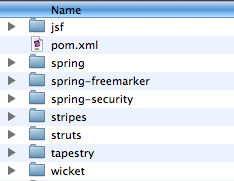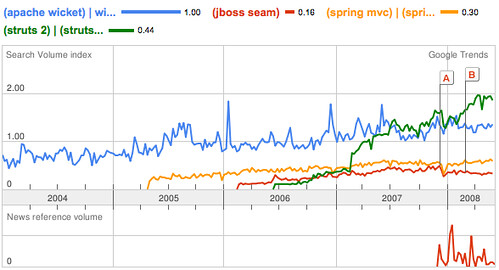Subbu works at Yahoo! developing standards, patterns and practices for HTTP web languages. In the past, he was a web service and Java developer. He was also a standards contributor at BEA and an author of books on Java EE. His current passion is HTTP and REST. Subbu confesses that he's not a web developer, has no interest in the internals of programming models used for web frameworks and he's only interested in the visible aspects of the architecture.
"The Web is Mostly Restful"
Being RESTful in an abstract sense means:
- Resources are named by URIs
- Resources have representations (Atom, HTML, JSON, XML)
- Resources contain contextual links to allow navigation of state
- There's a Uniform Interface
In the web today, some resources and URIs are personalized, but most are not. Some depend on sessions, but most do not. The consequence of a personalized UI with a non-unique URI is you cannot rely on browser caching.
The web is full of different representations (HTML, XML, JS, PDF, CSS, Flash). The problem with HTML is you can't tell links that you want a particular representation based of a link. The links are hard-coded to be a particular content-type. However, some media types on responses are ignored. This is often a problem with browsers and whether the user has plugins installed.
The Uniform Interface for the web is HTML and primarily links and forms (GET and POST). There's still some misconceptions (e.g. POST is secure). However, it's not about security, it's about idempotency and safety. You need to make sure you only use POST when you're changing data. POSTs are not repeatable. GET URIs are not always refreshable, which is quite unfortunate. Users shouldn't have to fight the back button.
Caching is a fundamental aspect of the web. Even in a personalized site, most of the content can be cached. The web is read-only for the most part. However, many enterprise web applications don't take advantage of caching. This is fine when there's not that many users, but it's bad when you want to scale to thousands of users. There's several frameworks that use cache-busting and prefer backend caching over HTTP caching. These frameworks are not using the web like they should.
Backend caching (e.g. Memcached) uses a non-uniform interface and you need to explicitly program to it. Frontend/HTTP caching has a uniform interface that's pluggable. Backend caching is generally more expensive to develop and deploy. There are cases where data should be cached on the backend, but you shouldn't focus all on backend caching w/o doing some frontend caching.
With Ajax, you get more opportunities to be RESTful. XMLHttpRequest is another HTTP client that can be programmed to. It has full support for the uniform interface, which allows content negotiation, optimistic concurrency and caching. Cross-domain hacks can be done with <script> and <iframe> to tunnel requests over GET. The W3C has been working for the last two years on how to do cross-domain Ajax w/o using hacks. The problem with current cross-domain implementations is they often use GET for everything, which isn't very RESTful. Subbu recommends using a proxy on the same domain if you do need to talk to other domains. This will allow your Ajax code to remain RESTful.
Web Frameworks
Web development is hard because of all the moving pieces that exist. Because of this, many web frameworks have been created to solve the various problems. In 1997, there were servlets. They provided basic plumbing and closely reflected HTTP/1.1. Servlets provided a poor programming model, but it allowed a lot of frameworks to be built on top of it. We don't use servlets to write applications, only to write application frameworks. The second era came about in 2001 when Action-oriented frameworks became popular. In 2004, JSF and friends came to play. JSF is a component-based framework with known limitations (complex, slow, uses POST for almost everything, Ajax is difficult). These limitations have resulted in a number of third-party patches being developed to solve these issues.
JSF was designed to use the request to create a component tree that maintains state. Unfortunately, the state is not something the developer has control over. It's not the state of the application, it's the state of the components. The client's knowledge of the state is mentioned with a cookie and the server keeps the state in the session. The problem with JSF is you don't have a choice of state in your application - you can't write stateless applications like you can with servlets.
JSF uses overloaded URIs for its resources. When you have one URI with multiple representations, there's no way to tell how a representation was chosen. JSF's compromise is to allow client-side state saving. However, they do this by putting hidden field in the form and requiring POST for navigation.
JSF vs. REST
Basically, these two are at opposite extremes. JSF is focused heavily on a UI component model. The people that developed it misinterpreted how the web works and made some fundamental questionable choices. You can patch it, but you can not fix it.
Web 2.0 Frameworks
GWT is a cross-compilation based framework. You write Java to generate JavaScript (b/c everyone hates writing JavaScript). It mashes client and server code into a single source. These layers communicate using GWT-RPC. Typical RPC concerns do not apply since code generation handles coupling and the client is downloaded from the same application. GWT-PRC does POSTs to the server and uses HTTP like a transport layer. To be fair, GWT does allow you to use a RequestBuilder to use the web like it should be used.
This class allows more control over HTTP requests, it supports GET and POST and it allows so-called RESTful layers (GWT-REST and GET-Restlet). GWT is focused heavily on ease-of-use, which is good. It's modeled after RPC and breaks the uniform interface and focuses on backend caching. Unlike JSF, GWT is fixable, but the community tends to use RPC instead of RequestBuilder.
SOFEA has a central promise of SOA. Business logic is a reusable service that changes less often. The presentation application calls those services and changes more often. The nice thing about this type of architecture is it allows a separation of concerns and loose coupling. However, it doesn't embrace REST like it should. Appcelerator is an implementation of SOFEA that has a Ruby on Rails-like usability. However, it uses a SOAP/HTTP style with messaging and POSTs to a single URI. Appcelerator is interesting, but it introduces a different style of coupling. It breaks URI opacity and client deals with POX instead of links.
Conclusion
Don't fight the architecture of the web. Innovate and enhance instead of breaking. If nothing else, break judiciously. As developers, we should demand more from our frameworks and make sure they use the web and HTTP like it should be used.
![]() The AppFuse Team is pleased to announce the first milestone release of AppFuse 2.1. This release includes upgrades to all dependencies to bring them up-to-date with their latest releases. Most notable are Hibernate, Spring and Tapestry 5.
The AppFuse Team is pleased to announce the first milestone release of AppFuse 2.1. This release includes upgrades to all dependencies to bring them up-to-date with their latest releases. Most notable are Hibernate, Spring and Tapestry 5.





